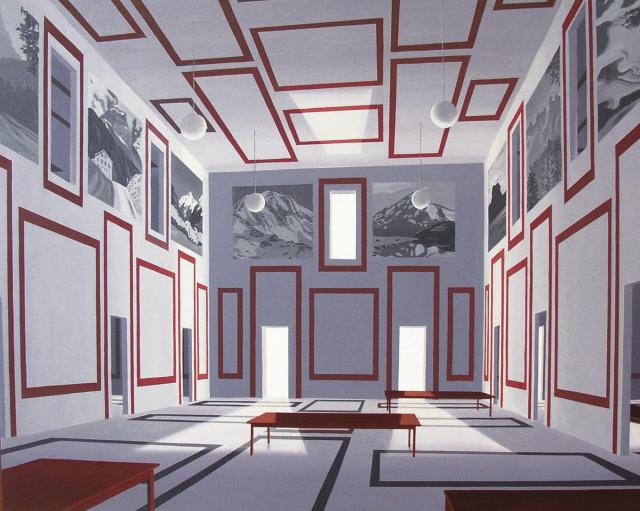How to bring off an artistic intervention in a hall with no natural light, where sound is absorbed by a carpeted floor and the décor itself, done in a contemporary style, is punctuated by walnut framing?
In a gesture that shows real generosity, Thomas Huber has created three paintings that are specifically designed for the site and which outwit, so to speak, the commission’s initial constraints by expanding the existing space through a depiction of great imaginary depths. Interior views show a pared-down architecture, empty of all human presence and made up of great high-ceilinged rooms set with doors and windows.
To infuse the whole with life and energy, as the artist explains, “red frames, rectangles, have been painted on the walls of all the paintings. They frame the windows as well as the doors, and are also found between the two, the doors and windows, on the walls. Red frames, frames of paintings. They are the sign that there is an image here.” This architecture is solely inhabited by the tables arranged on the floor and the black-and-white Alpine landscapes painted high up. Paradoxically, these images of famous Swiss peaks are not framed. Tokens of a long pictorial tradition, they are treated like large-format photographic prints arranged directly on the walls and conjuring up wall frescoes.
The artist isn’t shy about mixing different visual references to create a timeless place. On the other hand, these landscapes work like clues that visually connect the canvases as being different parts of the same room. Visitors finding themselves at the centre of the hall get their bearings between the two lateral paintings as if they were between the wings of a north-south nave. The painted architecture then becomes a site that is lived, experienced, and the play of illusion reaches its culmination in this interaction with viewers.
Like a bank that has accumulated two centuries of existence and possesses a collection of Swiss art that covers a period from 1805 to the present, Huber has built bridges between a classic past and an aesthetic that is akin to the digital image. With this project for the Pictet Bank, Thomas Huber shows us his sensibility and mastery of on-site painting. He plays on empty and full spaces, the fictional and the real, to demarcate a space that is both constructed and illusory.
In a gesture that shows real generosity, Thomas Huber has created three paintings that are specifically designed for the site and which outwit, so to speak, the commission’s initial constraints by expanding the existing space through a depiction of great imaginary depths. Interior views show a pared-down architecture, empty of all human presence and made up of great high-ceilinged rooms set with doors and windows.
To infuse the whole with life and energy, as the artist explains, “red frames, rectangles, have been painted on the walls of all the paintings. They frame the windows as well as the doors, and are also found between the two, the doors and windows, on the walls. Red frames, frames of paintings. They are the sign that there is an image here.” This architecture is solely inhabited by the tables arranged on the floor and the black-and-white Alpine landscapes painted high up. Paradoxically, these images of famous Swiss peaks are not framed. Tokens of a long pictorial tradition, they are treated like large-format photographic prints arranged directly on the walls and conjuring up wall frescoes.
The artist isn’t shy about mixing different visual references to create a timeless place. On the other hand, these landscapes work like clues that visually connect the canvases as being different parts of the same room. Visitors finding themselves at the centre of the hall get their bearings between the two lateral paintings as if they were between the wings of a north-south nave. The painted architecture then becomes a site that is lived, experienced, and the play of illusion reaches its culmination in this interaction with viewers.
Like a bank that has accumulated two centuries of existence and possesses a collection of Swiss art that covers a period from 1805 to the present, Huber has built bridges between a classic past and an aesthetic that is akin to the digital image. With this project for the Pictet Bank, Thomas Huber shows us his sensibility and mastery of on-site painting. He plays on empty and full spaces, the fictional and the real, to demarcate a space that is both constructed and illusory.
